The main thing we’re focusing on here will be what Manning and the Broncos should do in 2015 to construct a roster that gives them the best chance at winning the Super Bowl, but we’ll also be addressing the Manning vs Brady debate that has been going on since the early-2000s and that New England fans think is finally settled.
I’ve always been very interested in the Manning/Brady debate and I hope I can bring a unique perspective your way with this analysis as I don’t think anyone has taken this approach. Below, we’ll be looking at their cap numbers and the percentage of the cap both quarterbacks took up over the course of their careers. Then we’ll look at how their cap hits affected the team that was constructed around them by analyzing their team stats over the years.
I do think through analyzing both of their careers from a cap perspective, we’ll be able to better understand the argument of who’s the better quarterback, but also better understand the impact that the salary cap can have on a team regardless of how good the player is. Very few doubt that Peyton Manning is the greatest regular season quarterback of all-time, but has his success and salary hurt him from being called the greatest quarterback of all-time?
By the end of this, I think I’ll put together a case that I hope would convince Peyton Manning and Tom Condon that a pay-cut is the best option for Manning from a financial standpoint. Heading into the last season or two of his career, Manning has a decision to make: do I want to make about $40-43 million these next two years or do I want to make a little less, win a Super Bowl or two and go down as the greatest quarterback of all-time?
I would argue that Tom Condon has a fiduciary duty to convince Manning that giving himself the best shot at a Super Bowl, in essence, betting on himself, will create more income for him in the long-run. Two or three Super Bowls sounds a lot better than one!
Let’s get to it…
(As always, click on the figures to enlarge them. If you have a Mac, hold the command key and click on the figures to open them in another tab.)
Figure 1: Manning vs. Brady: Cap Hits
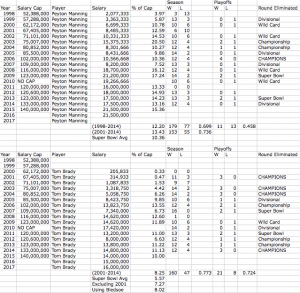
Figure 2: Super Bowl QB Cap Hits

Figure 3: Manning Team Stats
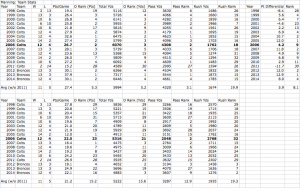
Figure 4: Brady Team Stats
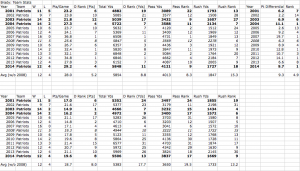
Figure 5: Manning vs. Brady Stats
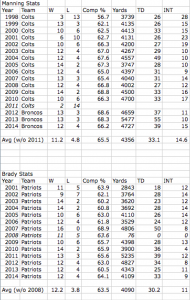
Figure 6: Offensive Rankings for Super Bowl Champs
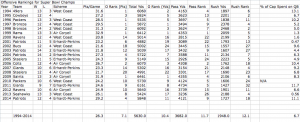
Figure 7: Defensive Rankings for Super Bowl Champs
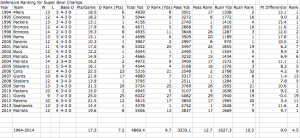
As you’ll see in the figures above, Manning has consistently had a much higher cap hit than Brady over the course of his career and my argument is that his cap percentage has been a huge factor in his playoff struggles over the course of his career.
When you compare Manning’s cap charges over the course of his career, he’s cost his team 3.95% more of the cap per year. Just looking at team’s top 10 cap charges in 2014, an extra 3.95% of cap space could help you sign free agents over the years like Elvis Dumervil (2.54%), Donte Whitner (3.2%), Chris Clemons (3.92%), DeSean Jackson (3.2%), Connor Barwin (3.68%), Dominique Rodgers-Cromartie (2.07%), or Golden Tate (2.33%).
That was just a display of what 3.95% could get you on the free agent market, but even MVP level players like JJ Watt (3.44%) and Antonio Brown (3.40%) cost less than the 3.95% more of the cap that Manning took up. Obviously, this isn’t me saying who the Colts or Broncos could have gotten over the years, just a display of what that kind of cap percentage can get a team. Due to this, I think that extra 3.95% is a huge deal.
When we’re discussing Brady, the fact that he won three Super Bowls by his fourth season enabled them to have a championship caliber team around him due to his low cap hits. His ability to work with the Patriots to have a team friendly contract also has allowed him to be surrounded by a Super Bowl caliber team throughout his career.
When you compare their Super Bowl winning years, Manning’s cap charge was 10.36% during his 2006 season, while Brady averaged 5.57% over his four Super Bowl winning years. Even when you use Bledsoe’s cap number instead of Brady’s in 2001 since he was their number one cap hit, his Super Bowl average is till 2.34% lower than Manning’s. An extra 2% of cap space is similar to what Rodgers-Cromartie cost the Giants this year and a great cornerback can be the difference between winning a Super Bowl or not. In fact, Julian Edelman cost the Patriots 2.07% of the cap this year with the extension he signed in March of 2014. If Brady had a contract like Manning’s, do they have the space to sign such an important piece of their Super Bowl run? Or do they just decide to roll with Amendola and draft his back up?
Manning vs. Brady: Team Offense and Team Defense
When you look at the statistics of team offense and defense, you really get an idea of how much Manning’s cap number could have hampered the Colts over the years. In 2004, Manning lost to Brady in the AFC Championship game 20-3. While Manning had a historic year with 4557 passing yards and 49 touchdowns, which was a record at the time, he took up 20.50% of the salary cap, which is 7.42% more than Steve Young took up in 1994 as the highest Super Bowl cap hit of the salary cap era.
I would argue that the fact that Manning took up one-fifth of the Colts cap that year, is why their defense was one of the worst in the NFL and is a huge reason why the Colts lost to the Patriots that year. The Colts defense was 19th in points allowed, but 29th in yards with their pass and rush defense both being below 24th in the NFL. Their rushing offense was 15th in the NFL.
For 14.24% less of the cap, the Patriots got Tom Brady for 6.26% of the cap and while he didn’t have as good a year as Manning, the team was built to win in the playoffs with a rushing attack that was 7th in the NFL and a defense that was 2nd in scoring defense and 9th in yards allowed. That 2004 season really stuck out to me as a salary cap lesson. Sure, Manning might be the greatest regular season quarterback of all-time, but you can’t win in the playoffs without a more balanced team.
Even during Manning’s Super Bowl winning 2006 season, the Colts were 18th in the NFL rushing the football, their defense was 23rd in points, 21st in total yards and they were the worst rush defense in the NFL. A huge x-factor during that playoff run was a healthy Bob Sanders, who only played four games during the regular season, but helped the Colts give up only 73.3 rushing yards per game during their playoff run.
Since Manning has rarely had a balanced team, great playoff teams, teams that are balanced and have great defenses are able to dare Manning’s teams beat them with the rushing game and so many times, they’ve been unable to do that.
I don’t think it’s a coincidence that during Manning’s 29 and 31 year old seasons, which sandwich his Super Bowl 2006 season, he had two cap hits under 10% of their salary cap and the Colts had the number one scoring defense in each of those seasons. These were also the only two seasons of Bob Sanders career that he played more than six games.
Unfortunately for the Colts, during that 2005 season, they lost by three to a Steelers team on their way to a Super Bowl in the Divisional Round and in 2007, they lost to the Chargers by four. In 2007, Marvin Harrison only played five games, which left Dallas Clark and Anthony Gonzalez as their second and third leading receivers with a combined 1192, which just isn’t enough if you’re going to be a pass-first team, with the 18th best running offense in the NFL.
In that Divisional game against the Chargers, Harrison had a small role and Antonio Cromartie covered Reggie Wayne for most of the game during the best season of his career and had a spectacular one-handed interception and forced a Marvin Harrison fumble.
Since Manning has rarely had a balanced team, great playoff teams, teams with great defenses have often been able to dare Manning’s teams beat them with the rushing game and so many times, the Colts and Broncos have been unable to run the ball.
When I compare the offensive and defensive team stats of the two teams Brady and Manning have quarterbacked, I note the sustained balance of the Patriots over the last 15 years. The Patriots have had a point differential 3.4 points higher than Manning’s teams. When I look at teams build to win in the cold of the playoffs, I look for rushing and rushing defense and the Patriots are better in both of those because they’ve been more balanced over their careers.
So much of the playoffs, as we saw in January of 2015 especially, come down to game planning and match-ups. In 2005 and 2007, when Manning had the best defenses of his career, he ran into two teams in the Steelers and Chargers who matched up very well with them because of defensive backfields made up of players like Ike Taylor and Troy Polamalu, then Antonio Cromartie and Quentin Jammer.
The Patriots are the team that’s exploiting your weakness because they’re good enough at everything to do it. Balance isn’t being the best passing and rushing team in the NFL because that’s just too hard to do in this era. Balance is being able to ram LeGarrette Blount down the Colts throat like the Pats did in January because you’re good enough to do that. The Patriots have been doing that kind of stuff for a decade and a half, it helps that they have one of the greatest football minds ever, but it also helps that they have one of the best quarterbacks ever for a very reasonable cap number.
2014 Broncos and What It Means for 2015
Now, the 2014 Broncos were one of the most well-balanced teams of Peyton Manning’s career, but unfortunately, he had that right thigh injury that we all saw really hamper his abilities against the Colts. I’m a firm believer that he has a lot left in the tank, I think he’s still the quarterback who was on pace for 5280 yards and 48 touchdowns, while completing 67.08% of his passes through 10 games. Those yardage and touchdown totals would both be in his top three for his career.
It’s no coincidence that his numbers began to falter when Julius Thomas went down against the Rams in game 10. Throughout his career, Manning has been very reliant on the tight end. Even during his first year in Denver, Jacob Tamme and Joel Dreessen combined for 93 catches 911 yards and seven touchdowns.
Heading into that St. Louis game, Julius Thomas had 38 catches for 423 yards and 12 touchdowns in his first nine games, which ends up only being 47 yards a game, but opens the field up for the rest of the passing game. Once Thomas went down, opposing defenses didn’t need to worry about the tight end, even when he was playing, he was unable to play full speed. Excluding the three catches for 46 yards and a touchdown that Virgil Green had in Week 17 against Oakland, the Broncos had 14 catches for 128 yards over five games, only 26 per game.
When you look at Manning’s career, tight ends have always played a vital role in his offenses. Over the course of his career, they’ve accounted for 21.1% of his passing yards and 25.7% of his passing touchdowns. They’ve always been a vital part of his red zone success as evident by the massive impact Julius Thomas has had scoring touchdowns the last two years.
Excluding the 2011 season that he was injured, from 2006 to 2013, Manning’s tight ends have averaged 104 catches for 1075 yards and 9 TDs. The only time Manning had a tight end with over 1000 yards was in 2009, when Dallas Clark went for 1106 yards. Over those seven seasons, only 13 tight ends had over 1000 yards, yet Manning’s assortment of tight ends have combined to average Pro Bowl numbers.
Figure 8: Manning’s Tight Ends
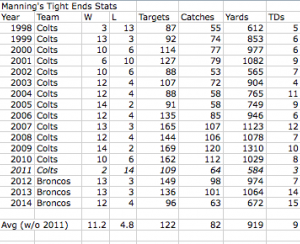
Figure 9: Leading Tight Ends from 2006-2014
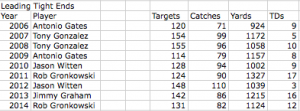
Julius Thomas is the most athletic tight end Manning has ever had in his career, but he has some question marks like injuries, blocking skills, and the fact that he hasn’t had more than 800 receiving yards in a season, yet will command top market value. Seeing the importance of tight ends in a Manning offense and the growing importance of the tight end in the NFL, I think the Broncos need to resign Thomas if they want a shot at the Super Bowl.
I do think that signing a less heralded, cheaper player like Charles Clay or Jordan Cameron and drafting someone like Florida State’s Nick O’Leary in the second or third round. Even drafting Maxx Williams in the first round could be the way to go if Thomas leaves, but I would certainly sign a veteran because of the time it takes for a tight end to develop. There are a lot of different choices they could make if they don’t resign Thomas, but I’d rather stick with a more known commodity if I were them.
One thing I’ve researched a bit this past week is production by top tight ends as rookies and I’ve come to the conclusion that tight end is a position where players need a few years to develop. They need to be NFL ready as blockers and pass catchers to produce, while running backs and receivers obviously both have to do this as well, more is asked of tight ends as inline blockers and pass catches, so it’s very unlikely that the Broncos will be able to plug-and-play a rookie who can play at a Super Bowl level.
Here are the rookie stats of some of the best tight ends over the last 20 years and some of the best young tight ends like Clay, Coby Fleener and Zach Ertz.
Figure 10: Top Tight End Production as Rookies
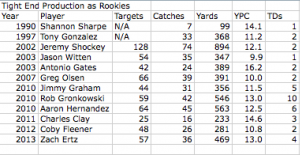
Jeremy Shockey and Rob Gronkowski are the only guys with rookie year numbers comparable to what Manning has come to expect from the tight end position. I don’t think there are any tight ends in the 2015 draft ready to produce at that level as rookies, so if they let Thomas go, they will definitely need to replace him with a veteran free agent. Like when Manning missed the 2011 season, we saw how valuable Thomas was in his absence as Manning struggled down the stretch.
I mention all of this because I think that Manning’s 2014 Broncos were the best overall team he may have had in his entire career. They had talent in all the right places and spent their money on the right positions with their top 11 cap charges being on the pass game positions that I spoke of in my analysis of Super Bowl Champions.
Figure 11: 2014 Broncos Top 10 Cap Hits
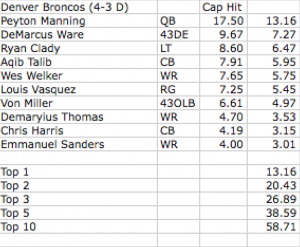
According to Pro Football Focus, Ryan Clady and Wes Welker were the only players in this group who had bad seasons with both of them being in the negatives, but outside of that, I think the Broncos had a well constructed salary cap for the year with money being spent in the right places.
Heading into the offseason, they’re similarly set up in 2015, but that’s before we factor in the free agents that they’re almost certainly going to want to resign: Demaryius Thomas, Julius Thomas, Terrence Knighton, Brandon Marshall and Orlando Franklin. Then there are the next level of guys who they would probably want for the right price like Rahim Moore, Jacob Tamme, Virgil Green, Will Montgomery, and a few others who will probably be cheaper. They also must address some of their holes from 2014 and replace free agents they’ll be letting go.
Manning and the Broncos in 2015
While Broncos do have cap space, they won’t if they want to sign Thomas, Thomas and Knighton. At the end of 2014, they had $107.3 million, or 76.6%, of their 2015 cap locked in. Demaryius or Julius will be franchised for $12.8 or $8.33 million, so after that, the Broncos will be between $115.63 and $120.1 million.
Which leaves about $20 to 25 million for the entire rest of their team, including whichever Thomas they didn’t sign and Terrance Knighton. Considering the rate of the franchise tags, resigning all three near that rate for their talent would put them at $138-140 million. Considering that Julius Thomas reportedly turned down an offer that would pay him $8 million a year, he might cost even more that that franchise tag. I think that the weak tight end class this year also increases Thomas’ contract.
So with the cap about to be set between $140-143 million, they’re right there before they sign guys like Brandon Marshall, Orlando Franklin, Will Montgomery, Rahim Moore, any other positions they want to address and their draft picks.
If Manning wants all three of those key pieces to their success and more, then something must be done about his contract.
As Jason and I have both researched here on Over The Cap, the highest QB cap charge, the highest single cap charge of the salary cap era for a Super Bowl winner was Steve Young in 1994 when he took up 13.08% of the salary cap. As seen in the figure below, Manning’s 2015 cap hit will be two percentage points above that. Considering this is an era of quarterbacks, I think it increases how much better Manning has to be than Young to justify the increase in cap percentage.
Figure 12: 2015 Broncos Top 10 Cap Hits
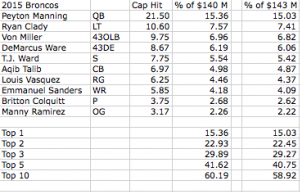
What’s more interesting to me is that in 2006 with the Colts, Manning took up 10.36% of the cap. He played the best football of his career in 2013 and was on a great pace this year before Julius Thomas went down, but is he 50% better at 39 in 2015 than he was at 30 in 2006? Is he that much better than Steve Young was at 33? That’s what the cap numbers say to me. To win a Super Bowl, the cap numbers are telling Peyton Manning that he has to be the most valuable quarterback in the history of the salary cap era.
What also sticks out when looking at their Top 10 cap charges is that they’re taking up about 60% of the salary cap without signing three guys who will end up in their Top 10. Manning’s huge cap number throws off the rest of the roster.
Figure 13: Super Bowl Top Cap Charges

As you see from the figure above, Manning’s cap number knocks the Broncos off the average charges of Super Bowl champs. The 2013 Seahawks’ Top 10 took up the most cap space of all Super Bowl teams with 61.31% with the 2012 Ravens second with 56.72%. As Jason and I have pointed out, the Seahawks were so out of the ordinary that you can’t measure most teams against them, with Russell Wilson taking up less than a percent of the cap along with all the other high value guys on cheap rookie deals, very few teams would be able to make up the mistakes they made with their cap that year.
It’s not that it’s impossible for Manning to win a Super Bowl with these numbers, but it’s about giving himself the best chance.
I’ve discussed on OTC before I’ve always been curious to what the best way to construct a team is, so that I can help advise my future clients to take contracts that maximize their earning potential, but also give them the best chance to win. While some players surely care about the money more than winning, winning is a lot more fun and at the stage that Peyton Manning is in his career, I’m sure he wants to win one more Super Bowl.
I would never tell a fellow American, “I do think at a certain point you’ve made enough money,” but with a net worth near $165 million, I do think another Super Bowl is worth more to Manning than the few million he could lose with a pay cut or restructure. I also think that being a two-time Super Bowl champion could be worth more to him than whatever he’d lose in income this season.
Now that Brady has won four Super Bowls, he’s probably overtaken Manning in the greatest quarterback argument. The average fan isn’t going to understand that the difference between Manning and Brady’s cap number over the years could be a huge reason why Brady had more playoff success. The only year that Brady had a higher cap number than Manning was that 2006 season when Manning beat Brady in the AFC Championship.
Conclusion
I think that these figures show just how spectacular Manning is as a player because of the incredible things he’s accomplished statistically and in the playoffs with a seemingly insurmountable salary cap figure. I think that agents need to fully understand the value of their players to the point of the maximum percentage their client can earn, while still allowing his team to succeed.
With many of his teams over the years, over the course of an entire season, Manning can put up historic numbers and make up for his team’s inefficiencies, but I think, the extra 3.95% more than Brady that he has cost on average over his career has made a huge difference in the playoffs. Manning’s career average of 12.20% is 5.49% more than the cap percentage of the average Super Bowl starting QB. Despite only winning one Super Bowl, I think his accomplishments despite his cap numbers should be recognized.
The fact that Manning brought the Colts to a Super Bowl in 2009 while taking up 17.24% of their cap is remarkable, but also illustrative of the downfall of spending that much on one player as they were 32nd in the NFL in rushing with less than 81 yards rushing a game and they had an average defense. Remember, NFL “capology” is a young field of study, I don’t think Manning or the Colts understood that his cap percentage made things much more difficult for them.
With Tom Brady’s success last year with a relatively low cap number, he’s started to affect the entire marketplace. People are calling for Ben Roethlisberger and others to restructure their contracts to give their team the best chance to succeed, and they’re right. Tom Brady has changed the game and in a way that will help all players as there will be more money to go around.
What we are beginning to see is the quarterback bubble burst like in any marketplace. Whether it’s a financial or housing bubble, or the coming burst of the higher education bubble, a market will always correct itself. We’ve seen this at the wide receiver and cornerback positions in recent years after the huge deals for players like Mike Wallace, Percy Harvin, and Brandon Carr.
Brady and Manning are two of the greatest quarterbacks of all-time and while I think Manning is the more talented player, Brady’s biggest advantage has been his much lower cap number over his career. In speaking with Jason, we agreed that Manning and the Broncos should agree on a contract somewhere in the neighborhood of the $14 million that Tom Brady will be making in 2015. This will put his cap percentage at 10% and allow the Broncos to build a scary good team around him. That extra $7 million could allow them to resign everyone they need to and then get a big-time WR3 in a deep market, someone like Jeremy Maclin or even Michael Crabtree at a low-cost.
If Manning drops that cap number, look out.
If you have any questions or want to start up the discussion, comment below or tweet me! I’ve been in Indianapolis this week for the combine and it’s about zero degrees with a wind that shoots through your body, I literally have no idea how people lived in the north before legitimate heating existed. Do not go outside this weekend, just stay inside, watch the combine, relax and read Over The Cap. I give you permission.
Zack Moore
If you want to purchase The First Annual Caponomics: Understanding NFL Roster Building through Super Bowl Champion Salary Cap Analysis, which has analysis like this in it, please e-mail me atCaponomics@gmail.com, so that I can put you on our e-mail list for people interested in purchasing the book.












